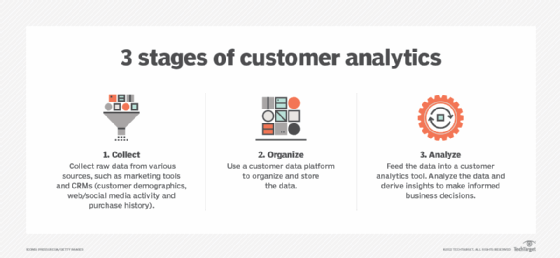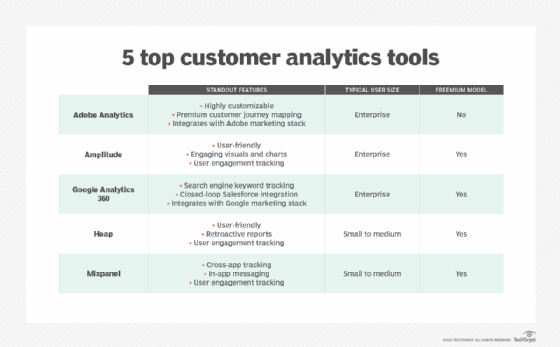
customer analytics (customer data analytics)
What is customer analytics?
Customer analytics, also called customer data analytics, is the systematic examination of a company's customer information and behavior to identify, attract and retain the most profitable customers.
Why customer analytics matters
Customers in the digital era have information at their fingertips about where to find goods and services, what to buy and how much to expect to pay. They can find the perfect products for their needs, and therefore, organizations must do everything they can to serve the right products and marketing campaigns to their audience. To do this, organizations can use customer analytics tools to understand their customers.
The goal of customer analytics is to create a single, accurate view of an organization's customer base, which can inform decisions about how to best acquire and retain future customers. It can also identify high-value customers and suggest proactive ways to interact with them.
Organizations that deeply understand their customers' buying habits and lifestyle preferences can more easily predict those people's behavior and, therefore, can optimize the customer journey. Accurate analysis requires large amounts of accurate data. Without this, analysis insights may be wildly wrong and unhelpful.
How customer analytics works
Customer analytics is often managed by an interdisciplinary group of leaders from different departments, including marketing, sales, customer service, IT and business analysts. To obtain meaningful insights, the group must agree on which business metrics can comprehensively view the customer experience.
Customer analytics starts with raw data and ends with intelligent business decisions. Before the data can inform decisions, it must pass through three stages: collection, organization and analysis.
Collection. First, organizations must take in raw customer data from various sources, such as marketing tools, CRM systems or third-party sources. Such data may include the following:
- Demographics.
- Purchase history.
- Web and social media activity.
- Contact center interactions.
- Advertisement engagements.
- Survey responses.
Organization. Next, organizations must format the customer data to work in a customer analytics tool because unorganized data may produce an inaccurate customer profile. Multiple instances of CRMs, disparate enterprise resource planning systems or poor customer data integration can lead to inaccurate results. A customer data platform (CDP) can help organizations store and organize their data in a central location.
Analysis. A customer analytics tool helps organizations make sense of their collected data and can display trends in the form of charts and graphs. For example, the tool can combine demographics, purchase history and social media data. With these data points, the tool can produce a chart that reveals the organization's most valuable customer segment is middle-income women from New England who follow that organization on Instagram.
Organizations can derive insights from the tool's results and use them to make more informed business decisions. In the case of the preceding example, the organization may elect to increase its Instagram marketing budget or send personalized offers to women in New England.

Customer analytics best practices
Organizations can use the following best practices and customer experience metrics to create successful customer interactions.
- Target customers across all channels and analyze how to distribute a product or service.
- Assess and understand customers in relation to the brand and whether a customer is satisfied. This can be achieved through a combination of quantitative and qualitative surveys.
- Engage with customers at the right moment through the right channel.
- Predict churn rate and take actions to extend a customer's lifetime value.
- Spot trends in big data and analyze online behavior to increase sales.
- Optimize the customer journey through personalized selling and market segmentation by assessing which customers might buy one type of product versus another.
Customer analytics tools
Customer analytics tools are specialized apps used to improve the customer experience, understand customer behavior and help tailor marketing campaigns to specific customer segments.
These customer data analysis tools can be part of a CRM suite or sold as standalone platforms that do everything from collecting customer data from different systems in different locations (data integration) to data analysis and visualization. These tools also connect to popular sales and marketing applications, web content management systems, email, social platforms and customer loyalty programs.
Organizations have many customer analytics tools to choose from. Some tools from major vendors include the following:
- Adobe Analytics.
- Amplitude.
- Heap.
- Google Analytics 360.
- Mixpanel.
Many highly customizable analytics tools, such as Adobe Analytics, require experienced professionals to operate them, whereas simpler tools such as Heap may be better suited for the average user. Adobe Analytics, Amplitude and Google Analytics 360 typically serve large enterprises, while Heap and Mixpanel tend to benefit small to mid-sized organizations.

Cookies and the future of customer analytics
When people browse the internet, the websites they visit can send a text file known as a cookie to their browser containing identifying information. Cookies allow websites to collect information about a user's session for personalization purposes. However, not all cookies are the same.
First-party cookies are restricted to the website that sent them and serve to improve the site's UX. For instance, they let a website remember what items customers put in their shopping carts. Third-party cookies, on the other hand, come from websites other than the one a person visits and are more controversial. Advertisers can use them to track a user's session across multiple sites and target them with personalized advertisements based on their activity.
Customer analytics uses data to generate marketing insights, and third-party cookies have been a major source of that data since the 1990s. Apple Safari and Mozilla Firefox browsers have blocked third-party cookies since 2013 due to privacy concerns, while Google has held on to them. However, Google plans to eliminate these cookies from its Chrome browser in 2024.
Third-party cookie elimination leaves marketers with less customer data to feed into analytics tools and has organizations looking for other ways to create effective marketing campaigns. In March 2021, Google began testing the Federated Learning of Cohorts (FLoC) as an alternative to third-party cookies. However, they ended the project by July of that year after criticism over privacy concerns. In 2022, Google announced Topics as a proposed alternative to FLoC and began testing it in a developer trial.
Organizations shouldn't wait for Google to reinvent the third-party cookie and, instead, take the following proactive approaches:
- Make the most of first-party data. Unlike third-party cookies, first-party cookies aren't going away. Organizations should invest in CDPs and analytics tools to transform the data they collect from their sources into marketing insights.
- Collect zero-party data. Organizations can use creative methods, such as online quizzes, social media polls and loyalty cards to collect voluntary information -- zero-party data -- from their customers.
- Work with publishers. Many online publishers use an opt-in membership model to collect large amounts of first-party data that can provide clients with prospects and marketing insights.
- Use contextual marketing. A content source that shows ads relevant to its content is an example of contextual marketing, a targeted marketing form that doesn't require third-party cookies.






